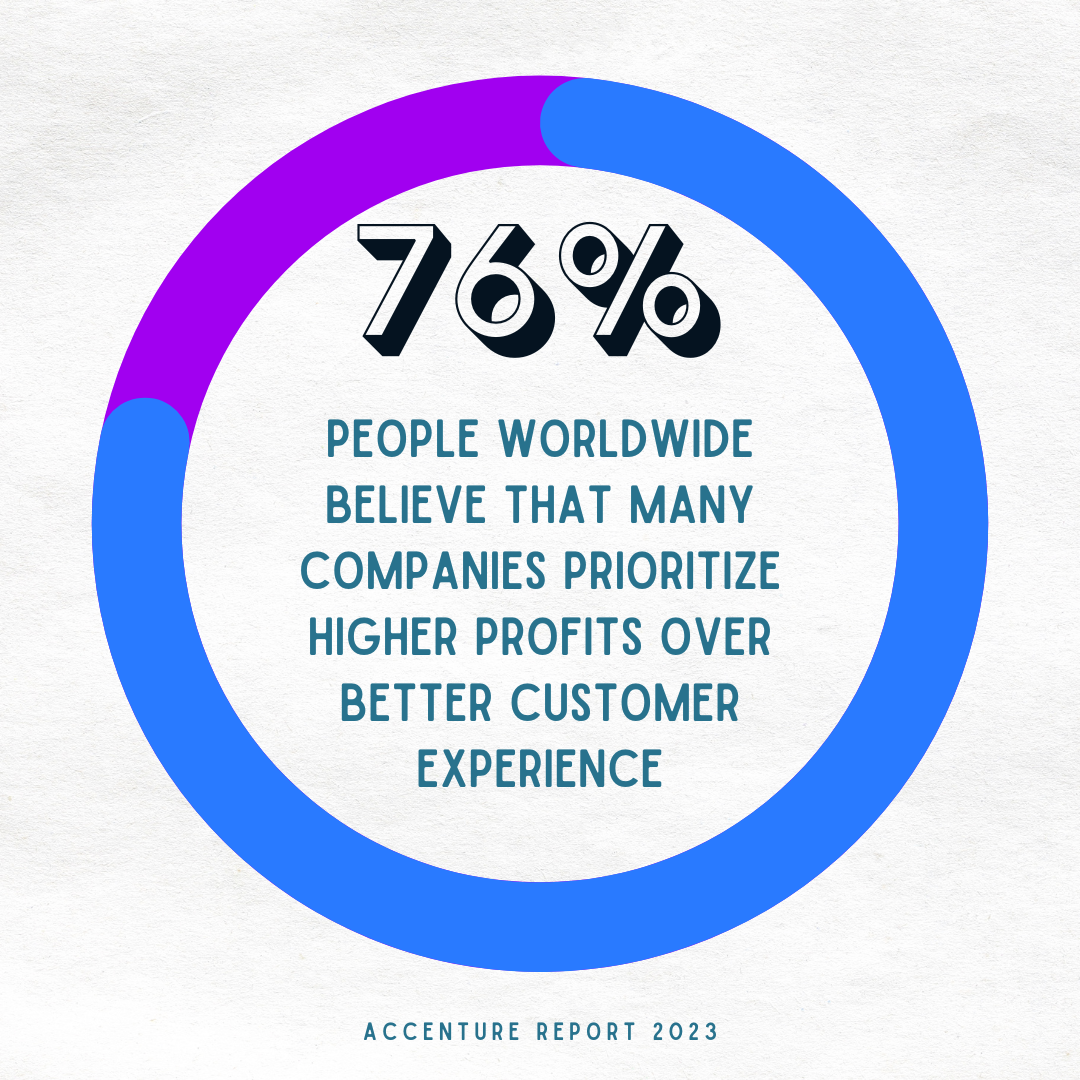2024: Consumer friction is on the rise
One of the driving forces behind the major trends for 2024 has to do with what we like to call "Consumer Friction." Consumer friction refers to the difficulties and challenges faced by consumers when interacting with brands and making purchasing decisions. This friction can arise from various factors such as rising prices, lower quality or quantity of products, and economic strains on consumers.
One of the key drivers of consumer friction is the combination of rising prices and a decrease in product quality or quantity. As a result, consumers are becoming more sensitive to these factors due to the economic strains they face. When prices increase but the quality or quantity of products decreases, consumers feel the impact of these changes on their purchasing power and overall satisfaction.
In recent years, consumers have become more conscious of making informed purchasing decisions. They are more likely to research and compare products, read reviews, and consider factors such as price, quality, and value for money.
With rising prices and lower product standards, consumers are faced with the challenge of making the right purchasing decision amidst limited resources.
Consumer behavior and the economy
Another trend theme is the impact of economic conditions on consumer behavior. When interest rates are low and money is cheap, consumers are more willing to take risks and try out new brands or products. This was evident during the coronavirus pandemic, where many direct-to-consumer (D2C) brands flourished.
However, with the current economic strains and inflation rates, consumers are becoming more cautious and hesitant to take risks. They are more likely to stick to established brands or products they trust, further increasing the friction between brands and consumers.
This consumer behavior has significant implications for marketers and businesses. It means that brands need to be more mindful of their pricing strategies, product quality, and value proposition in 2024. They need to ensure that they are providing products and services that meet consumer expectations and justify the price. Additionally, brands need to focus on building trust and loyalty with consumers to mitigate the effects of rising consumer friction.
Brands need to be aware of these challenges and adapt their strategies to ensure they meet consumer expectations and maintain strong relationships with their target audience. By addressing consumer friction, brands can navigate the changing market landscape and remain competitive in 2024 and in the years to come.
Consumer demand shifts during pandemic
During the pandemic, consumer demand underwent a significant shift. As the podcast transcript highlights, many brands faced challenges due to supply chain issues and tightening consumer demand. However, it is important to note that consumers were not necessarily refraining from making purchases altogether. Instead, they were opting for safer choices and gravitating towards brands they already knew and loved.
One of the consequences of this shift in consumer demand was the emergence of "tipflation" and "shrinkflation." These terms refer to the practice of companies cutting costs and reducing product quality, which can lead to consumers feeling dissatisfied with their purchases. This dissatisfaction is amplified when consumers see companies reporting record earnings while simultaneously delivering lower-quality products. This disconnect erodes trust and can prompt consumers to seek out alternative brands that prioritize customer experience and offer better value for their money.
Mike Mardis, Finch's Director of Marketing cites a statistic from an Accenture report, revealing that 37% of people worldwide believe that many companies prioritize higher profits over better customer experience. This sentiment aligns with the reality that 40% of CXOs (Chief Experience Officers) plan to raise prices to offset cost increases. The correlation between consumer perceptions and business practices contributes to the growing distrust among consumers.
In this context, building trust becomes crucial for brands. Consumer experience is a key aspect of this trust-building process. Mike emphasizes the importance of providing exceptional customer service and ensuring a positive consumer experience throughout the entire customer lifecycle, rather than solely focusing on the point of purchase. Brands that prioritize customer satisfaction and deliver a superior consumer experience are more likely to retain customers and stand out in a market characterized by uncertainty and distrust.

Nevin Zavell, Finch's Global eCommerce Specialist, explains why it is essential for brands to recognize the broader societal context in which they operate. He mentions the concept of "late-stage capitalism," which refers to the perception that companies are taking advantage of consumers and contributing to a dystopian economic landscape.
Brands should strive to distance themselves from this negative association and avoid being lumped into conversations that criticize the problems associated with late-stage capitalism. This requires a proactive approach to addressing consumer concerns and delivering value that surpasses mere profit-seeking.
Invest in customer experience long-term
Investing in customer experience long-term is essential for businesses to thrive in today's competitive market. The podcast transcript discusses the importance of prioritizing customer service and product quality to differentiate oneself from competitors and build a loyal customer base.
Mike highlights the negative impact of deteriorating product quality and poor customer service. He talks about his personal experiences with switching providers and witnessing broken game launches in the gaming industry. These examples emphasize the negative consequences of companies cutting costs or loosening standards, which ultimately lead to dissatisfied customers.
Nevin also acknowledges the challenges faced by executives in making business decisions. Says Nevin, "The pressure for companies to hit budgets and save money often results in decisions that negatively affect consumers." However, Nevin and Mike both emphasize that businesses should prioritize customer service and product quality over short-term cash grabs.
Says Mike, "I'd argue that investing in a better customer service apparatus and maintaining high-quality products will yield long-term gains and customer loyalty."

The importance of customer experience is further emphasized by the negative impact of poor customer service on revenue generation. If customers have a bad experience or are unable to get their issues resolved, they are less likely to return and make repeat purchases. This highlights the need for a strong customer service department that can genuinely and effectively solve customer problems.
Investing in customer experience should also extend to product quality. Consumers are becoming increasingly sensitive to perceived cut corners and are more likely to choose brands that prioritize quality. Therefore, investing in maintaining a high-quality product that stands apart from the competition is crucial.
Additionally, effective communication of the exceptional customer experience is essential. Brands should showcase their commitment to providing a world-class customer service experience from start to finish. This can be done through advertising and branding efforts, as exemplified by American Express, which has built its brand around exceptional customer service.
Customer experience drives long-term success
Nevin emphasizes the significance of customer experience in driving long-term success for brands. Says Nevin, "Brands that prioritize treating their customers well throughout the entire process are more likely to not only survive but thrive in the future." He argues that when consumers start to limit their shopping choices and stick to brands they trust, they will naturally gravitate towards those that have provided them with excellent customer service.
Mike emphasizes that this principle applies to all industries, whether it be e-commerce, meal delivery, gaming, or any other sector. Mike asserts, "Investing in a positive customer experience will always yield significant dividends in the long run, even if there may be some challenges in the short term." And as the economy begins to recover and accelerate, brands that have prioritized customer satisfaction will see the greatest benefits.
Our team feels validated by the Accenture report that supports their message. They believe that their emphasis on customer success and engagement aligns with the report's findings and the larger trend in the market.
Additionally, stagnation and boredom permeate the media landscape. There is a fixation on remakes, rehashes, and sequels across various media platforms, including movies, television, and music. However, do note that social media trends, particularly on platforms like TikTok, are shifting towards more postmodern and unhinged content. This indicates that consumers are becoming bored with the blandness of mainstream media and are seeking more unique and daring experiences.
Nevin suggests that this trend in media can also be applied to advertising. He argues that taking risks and standing out from the background of sameness can be highly beneficial for brands. By avoiding safe and predictable trends, brands have a greater chance of capturing consumers' attention and standing out in a crowded market.
To support this argument, Nevin shares a real-world example of a successful advertisement that stood out from the rest. He explains how a simple yellow rectangle image with a straightforward message outperformed other more conventional advertisements. This example demonstrates the power of being refreshing and different in the market.
Be unexpected; take risks
The main takeaway of this article is the importance of being unexpected and taking risks in marketing and advertising strategies. Mike and Nevin emphasize that simply replicating existing content or following conventional approaches will not make a brand stand out in a crowded market. Instead, they advocate for creativity, guerrilla marketing campaigns, and thinking outside the box.

In summary, playing it safe may seem like an instinctive choice, especially during challenging economic conditions. However, those who are willing to take a gamble on new strategies, creative messaging, and risks will ultimately reap the rewards. Nevin and Mike both encourage brands to be bold and differentiate themselves in a world where everything can feel bland and repetitive.
AI is an opportunity for innovation
There is a dangerous trend in traditional advertising, and that is its repetitive nature. Audiences are becoming increasingly bored with seeing the same commercials playing on loop. This presents an opportunity for brands to differentiate themselves by utilizing AI in their marketing efforts.
Obviously, technology in the AI space is advancing at a rapid pace, and this can make it challenging for marketers to keep up. And while AI has made it easier to create advertising content, it has also made it more formulaic and similar-looking. This leads to the question of why audiences are constantly exposed to the same types of ads.
And when you talk about AI, the subject of data tracking and privacy always comes up. Privacy concerns have become a reality, and people have come to accept that their information is readily available online. Also, the advancement of technology has resulted in numerous new marketing tools and AI-driven features. This rapid change can make marketers feel like they are being left behind.
However, these advancements in technology present significant opportunities for brands to grow. Brands need to adapt rapidly to keep up with changing interfaces and the increasing focus on AI. And Google and Bing are already integrating AI into their interfaces.
Advertisers must ensure accurate product data and feed high-quality data into AI algorithms. As interfaces continue to evolve, new technologies like mixed reality and augmented reality may play a role in how consumers interact with brands. We are very optimistic about the potential of AI to transform the way brands operate and interact with consumers.
Let me repeat: AI is the next big thing
The impact of AI on various industries, particularly marketing, is profound. We believe that AI has the potential to revolutionize the way businesses interact with customers and create content.
Of course, many people are already using AI, and it is changing the way people interface with technology. We predict that this trend will continue to unfold rapidly in the coming years, specifically mentioning 2024 as a significant year for AI advancements.
Furthermore, media is stagnating and becoming homogenous due to the influence of AI. Brands need to break away from this trend and do something different. Creativity and ingenuity are critical in digital marketing, as well as taking risks. Brands need to invest in long-term customer service and experience programs that may not yield immediate results but will ultimately pay dividends.
Study the industry for inspiration
Mike and Nevin also suggest that marketers should look to other industries for inspiration. By observing successful campaigns and advertisements in different fields, marketers can find innovative ways to translate those strategies into their own products and company ethos. This approach can help brands avoid stagnation and stand out in the market.
In conclusion, we'd like to emphasize that AI is an opportunity for innovation in marketing. It highlights the need for brands to adapt rapidly to changing technology and interfaces. We strongly believe that AI can lead to a shift from keyword-packed content to more conversational messaging strategies.
Moreover, AI has the potential to shake up the media ecosystem and provide new opportunities for brands to innovate. Overall, by embracing AI and taking risks, brands can stand out, deliver more engaging content, and build stronger connections with their target audience






